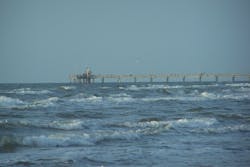New Legal Action to Address Gulf of Mexico Pollution
On Wednesday, environmental groups filed legal action against the Environmental Protection Agency’s (EPA) in an attempt to get the agenchy to address nitrogen and phosphorus pollution, according to a Natural Resources Defense Council (NRDC) press release.
This type of pollution stimulates excessive growth of algae, kick-starting a biological process that severely depletes oxygen levels in aquatic ecosystems and chokes marine life. An enormous example of this problem is the “Dead Zone” that forms in the Gulf of Mexico in the summer. In addition, toxic algae blooms result in fish kills, the death of livestock and pets, and damage to drinking water supplies.
Addressing Dead Zone pollution is thus necessary to restore health to the Gulf of Mexico and upstream waters of the Mississippi River Basin.
“The ecology and economy of the Gulf of Mexico have paid the price for EPA’s endless dithering about Dead Zone pollution,” said Matt Rota, director of science and water policy with the non-profit Gulf Restoration Network. “The most meaningful action the EPA can take is to set limits on the amount of these pollutants allowed in the Mississippi River watershed so that the fish and the fisheries can recover.”
Members of the Mississippi River Collaborative, represented by the NRDC, are challenging EPA’s denial of a 2008 petition to the agency asking EPA to establish quantifiable standards and cleanup plans for Dead Zone pollution. Separately, the conservation groups are seeking to compel EPA to finally respond to an even older petition––a 2007 request that EPA modernize its decades-old pollution standards for sewage treatment plants and include the Dead Zone pollutants nitrogen and phosphorus in those standards.
When scientists from the Louisiana Universities Marine Consortium completed their annual measurement of the 2011 Gulf Dead Zone, it measured 6,765 square miles––larger than the state of Connecticut—and it is growing, having doubled in size since 1985. In the Gulf, the pollution harms the $2.8 billion fishing industry.
The unrelenting problem of excess nitrogen and phosphorous has also proven costly upstream. For example, seasonally the Raccoon and the Des Moines Rivers in Iowa carry excessive levels of nitrates, requiring special treatment before the water is safe enough for Des Moines-area residents to drink.
The EPA called on states in 1998 to adopt specific limits on nitrogen and phosphorus pollution, and promised to enact its own limits if states had not complied by 2003. Every state along the Mississippi River ignored that deadline, and so far, only Wisconsin and Minnesota have taken effective action on their state’s contributions to the problem.
EPA’s continued lack of leadership at a federal level is a serious problem because the Mississippi River flows through or forms the border of 10 states, no one of which can act independently to fully protect the River. Only meaningful federal action by the EPA can unify states behind solutions that match the size of the problem at hand.
While residents up and down the river continue to wait for EPA to accept its leadership responsibility, inland water pollution problems have multiplied while the Dead Zone makes its annual appearance as a great blemish on America’s record of commitment to clean water.


